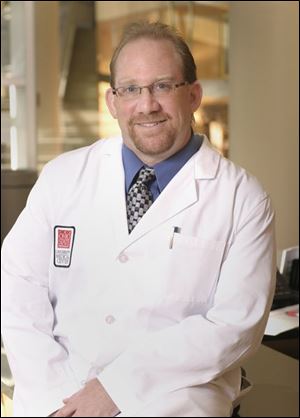
Gov. Strickland prescribes prevention for health woes
4/1/2007
Gayle Channing Tenenbaum, an advocate for needy children and their families, thinks the governor gets good marks for progress. Right now, we need stability, she says.

We can spend up front now with prevention or we can spend a lot of money later. Dr. Randy Wexler, Ohio State University Medical Center
COLUMBUS - Ohio has been a bit inconsistent over the years when it comes to investing millions to prevent diseases and health conditions it knows will cost billions to treat later.
In recent years, the state has spent more to insure children while cutting back coverage for their parents. It has increased investments in immunizations and flu vaccines while de-emphasizing physical education in schools and diverting hundreds of millions meant for anti-smoking programs to other purposes.
"Pay me now or pay me later," said Dr. Randy Wexler, a family medicine physician at Ohio State University Medical Center. "We can spend up front now with prevention or we can spend a lot of money later. As the population ages, that will become more difficult as people develop chronic diseases and suffer a significant decrease in quality of life."
In his proposed two-year, $52.9 billion budget sent to lawmakers last month, Gov. Ted Strickland calls for raising income limits to provide health coverage to Ohio's 155,000 uninsured children.
"That's the most cost-effective way to provide medical care, to make sure that children are immunized, to make sure that periodic checks are made. We will encourage that," Mr. Strickland said.

Gayle Channing Tenenbaum, an advocate for needy children and their families, thinks the governor gets good marks for progress. Right now, we need stability, she says.
The first Democratic governor in 16 years has proposed reversing some Medicaid cuts in dental, chiropractic, and other services imposed on working-poor adults under the prior Republican administration.
Mr. Strickland also wants to establish a position of physical education coordinator within the Department of Education just months after the General Assembly passed a law telling schools some students could be exempted from physical education graduation requirements.
And the governor plans to establish a Healthy Ohio Office within the Department of Health, using $4.3 million over two years to coordinate existing programs that promote healthier lifestyles and to look at what has worked in other states.

State Sen. Randy Gardner (R., Bowling Green)
Mr. Strickland said his health director, Dr. Alvin Jackson, will have a particular focus on reducing childhood obesity.
"If you look at coronary artery disease, in 1900 it was not a major medical issue," Dr. Jackson said. "A hundred years later, it's the No. 1 killer. That tells you that many issues are preventable. How we eat and exercise, how much sleep we get, what we do - these are lifestyle issues. Prevention can play a very great role in changing how people think."
There is much research to back up Dr. Jackson's words.
In 1980, the nation's health-care costs totaled $245 billion, an average of $1,066 for each American. By 2001, total health-care costs in the United States reached an astounding $1.4 trillion - $5,035 for each American - according to a 2003 study by the U.S. Department of Health and Human Services.
Most of that cost is spent on disease care, not health care, and much of the disease was preventable. According to the study:
•Direct medical costs attributed to smoking amounted to $75 billion a year, with an estimated $80 billion more a year pegged to lost productivity.
•Costs linked to physical inactivity were $76 billion a year.
•More than $33 billion a year in medical costs and $9 billion in lost productivity linked to heart disease, cancer, stroke, and diabetes were attributed to poor nutrition.
If you are not swayed by financial arguments, how about death itself?
More than 1.7 million Americans die each year of a chronic disease, accounting for about 70 percent of all deaths in the country.
"More than ever, it is critical that we, as a nation, step up prevention efforts to fight chronic diseases. The epidemic is fueled both by the aging of the U.S. population and by the poor lifestyle choices that Americans continue to make," the federal study concluded.
An individual's choice to lead a healthier life can pay big dividends.
The $53,000 savings of avoiding a single coronary bypass surgery could provide health insurance for a year for 12 people; the savings of avoiding a kidney transplant caused by diabetes - pegged at up to $150,000 - could provide insurance for 35 people for an entire year.
Dr. Jackson, the medical director of Community Health Services in Fremont, will take over as Ohio's director of health on May 1.
"The focus [of Healthy Ohio] will be on contacting stakeholders across the state to work together," Dr. Jackson said. "Ultimately, we all understand that we can save more money by preventing a problem as opposed to treating a problem."
Gayle Channing Tenenbaum, legislative director for the Public Children's Services Association of Ohio and senior policy fellow for Voices for Ohio's Children, said Mr. Strickland's budget is a strong step forward after several years of backward steps.
"Right now, we need stability," she said. "First, we get health-care coverage for all children and then move to as many families and adults [as] we can. We know that the smoking-cessation programs are funded for the next 10 years. There's time to figure out what to do about that in the future."
The state and federal governments have been talking about the importance of prevention for years. But Dr. Wexler said neither has shown the will to truly back up the rhetoric with cash, either in terms of direct patient care or developing the family practitioners most likely to detect and treat problems that could lead to heart disease, diabetes, or breathing problems.
"We have some of the fattest kids in America," he said. "We're seeing more teenagers with high blood pressure and sleep apnea. We had to rename juvenile and adult-onset diabetes to Type 1 and Type 2 because so many kids are overweight and obese that they're coming down with Type 2 diabetes.
"If you drop your blood pressure by 5 points, you reduce your risk of stroke by 14 percent and heart attack by 9 percent," he said. "That's very significant."
He said the government knows what it needs to do, having seen the United Kingdom, France, Canada, and other developed countries invest up front in prevention, ultimately spending much less on health care than the United States in the long run.
Sen. Randy Gardner (R., Bowling Green) questions whether Mr. Strickland's proposed expansion of health insurance to cover more uninsured children in moderate-income families might encourage some employers to drop family coverage.
And he doesn't like the fact that the governor's plan to use Ohio's tobacco settlement revenues ignores anti-smoking efforts.
But he applauds Mr. Strickland's championing of physical education in schools as well as his backing of Mr. Gardner's bill to require private insurers to cover diabetes-testing supplies and education.
"It's not a short scorecard," Mr. Gardner said. "He gets pluses. He gets question marks, and he gets minuses. I stand with him on diabetes and physical education, and I don't want to accentuate the minuses. The governor is right on a number of issues on health prevention."
But also on the table, he said, should be discussions about tax credits or other incentives for individuals or employers who pay for such things as weight-loss and smoking cessation.
Mr. Gardner has introduced a bill requiring Ohio to adopt standards for physical education, building on a proposal pushed by Senate Minority Leader Teresa Fedor (D., Toledo) that failed to pass in the General Assembly.
"It has not occurred in every school or area, but there has been a de-emphasis on physical education," Mr. Gardner said. "Ohio is the only state that doesn't have standards for physical education. We don't have a physical education coordinator, and we have a law that takes effect next week that says for the first time that some students don't have to take physical education as a condition for graduation."
Ms. Fedor said she recently met a mother whose child attends a suburban Cincinnati school that was cutting gym classes for financial reasons.
"Insurance companies, CEOs, and the health-care industry know that physical education in schools, especially in elementary schools, pays off with healthier lifestyles and healthier children," she said.
"It's a good investment," she said.
Through the State Children's Health Insurance Program and Medicaid, Ohio and the federal government provide regular checkups, immunizations, and screenings for such things as lead exposure for children through the age of 18.
Medicaid also provides prenatal care for pregnant women and preventive services for adults but not to the extent that it does for children.
"Other states have provided additional benefits to consumers as incentives for good-health behaviors," said Lorin Ranbom, a deputy director with the Ohio Department of Job and Family Services.
"For the most part, those rewards have been additional things that Medicaid could cover, such as over-the-counter pharmacy stuff - mouthwash, toothpaste, aspirin," he said.
While Ohio has discussed doing the same, it hasn't moved in that direction yet.
"You have to be able to measure health behaviors on a consumer-specific level, and you need the resources to do that," Mr. Ranbom said. "If it's a weight-loss program, at least you can measure whether people have lost weight or brought their blood pressure or triglycerides under control as a result of physician visits."
Blade politics writer Joshua Boak contributed to this report.
Contact Jim Provance at:
jprovance@theblade.com
or 614-221-0496.